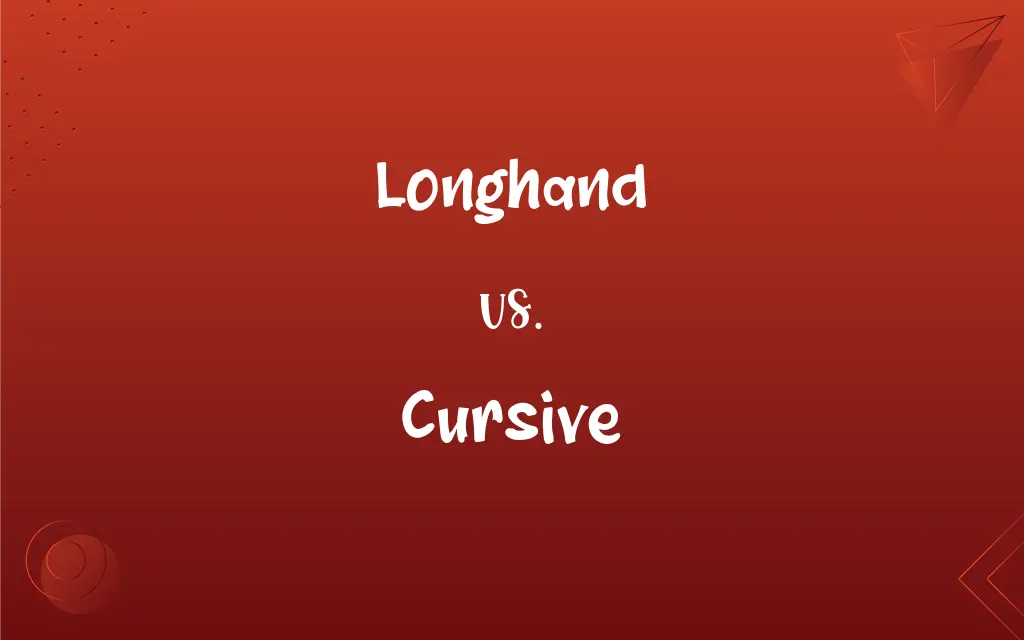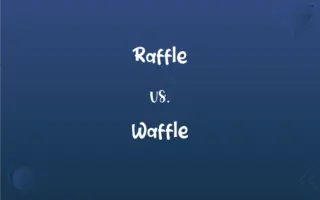Longhand vs. Cursive: What's the Difference?
Edited by Aimie Carlson || By Janet White || Updated on October 12, 2023
Longhand refers to standard handwriting with clear characters, while Cursive is a style of writing with flowing, connected letters.

Key Differences
Longhand, often called "print," is the style of handwriting in which each letter is written distinctly from the others, ensuring clarity and legibility.
Cursive, on the other hand, emphasizes a flowing and swift method of writing, where letters are often connected in a fluid manner. When people learn to write, they often begin with Longhand, mastering each character before transitioning to Cursive. Cursive's primary advantage is speed, as the continuous flow allows for quicker note-taking or writing in general.
However, Longhand's individualized characters can often be easier for others to read, especially if the Cursive writing is too hurried or messy. While technology has significantly influenced writing methods today, both Longhand and Cursive hold historical and stylistic significance in the realm of handwritten communication.
Comparison Chart
Style
Individual, separate letters.
Flowing, connected letters.
Legibility
Generally clearer to read.
Can be hard to decipher if written fast.
ADVERTISEMENT
Speed
Typically slower than Cursive.
Faster due to connected letters.
Learning Curve
Often taught first, easier to learn.
Taught after mastering Longhand.
Usage
Common in formal documents & texts.
Often used for personal notes & letters.
Longhand and Cursive Definitions
Longhand
The full, non-abbreviated form of writing words or phrases.
He always wrote his journal entries in Longhand, avoiding any shortcuts.
Cursive
A style of handwriting where letters are usually connected in a flowing manner.
She wrote her thank-you notes in elegant Cursive.
ADVERTISEMENT
Longhand
A synonym for manuscript, especially handwritten text.
The author's original Longhand manuscript became a museum artifact.
Cursive
Script writing characterized by consecutive characters.
Many signatures are written in Cursive for a personalized touch.
Longhand
A method of handwriting where each character is distinct and separate.
Her essay was written meticulously in Longhand, making it easy for everyone to read.
Cursive
Pertaining to a flowing, connected manner of script writing.
The old letter was written in a Cursive style that was hard to decipher.
Longhand
The manual inscription of characters as opposed to typed or digital text.
The teacher insisted on Longhand assignments to practice penmanship.
Cursive
Referring to the flow of hand movements while writing.
His Cursive strokes were so fluid, it looked like art.
Longhand
A writing style contrasting shorthand techniques.
Reporters often use shorthand, but she preferred to jot down quotes in Longhand.
Cursive
Having the successive letters joined together
Cursive writing.
A cursive style of type.
Longhand
Cursive writing.
Cursive
A cursive character or letter.
Longhand
The written characters used in the common method of writing; opposed to shorthand, or typing or printing; handwriting.
Cursive
A manuscript written in cursive characters.
Longhand
Written by hand in normal characters, as opposed to shorthand.
Cursive
(Printing) A type style that imitates handwriting.
Longhand
Written by hand (with pen or pencil), rather than printed out; handwritten.
I had to write the essay out twice longhand – they wouldn’t let me print it out. It took forever!
Cursive
Running; flowing.
Longhand
The written characters used in the common method of writing; - opposed to shorthand; as, took it down in longhand.
Cursive
(of writing) Having successive letters joined together.
Longhand
Rapid handwriting in which letters are set down in full and cursively connected within words without lifting the writing implement from the paper
Cursive
(grammar) Of or relating to a grammatical aspect relating to an action that occurs in a straight line (in space or time).
Longhand
Having words written out in full by hand;
Longhand writing
Cursive
(countable) A cursive character, letter or font.
Cursive
(countable) A manuscript written in cursive characters.
Cursive
(uncountable) Joined-up handwriting.
Cursive
Running; flowing.
Cursive
A character used in cursive writing.
Cursive
A manuscript, especially of the New Testament, written in small, connected characters or in a running hand; - opposed to uncial.
Cursive
Rapid handwriting in which letters are set down in full and cursively connected within words without lifting the writing implement from the paper
Cursive
Having successive letter joined together;
Cursive script
Cursive
A method of penmanship taught after mastering print handwriting.
After learning Longhand, the students progressed to Cursive lessons.
FAQs
Is Longhand easier to read than Cursive?
Generally, Longhand is clearer and more legible than Cursive, especially for those unaccustomed to reading Cursive.
What is Longhand writing?
Longhand refers to standard handwriting where each character is written separately and distinctly.
Why do some prefer Cursive over Longhand?
Many find Cursive quicker for note-taking due to its flowing nature, and some prefer its aesthetic appeal.
Is it essential to know both Longhand and Cursive?
While not mandatory, knowing both offers versatility in writing and ensures comprehension of various written materials.
Do schools still teach Longhand and Cursive?
While many schools teach Longhand, the emphasis on Cursive varies, with some opting out due to digital communication's rise.
Why is Cursive often used for signatures?
Cursive signatures tend to be more unique and personalized, making them harder to forge.
How does Cursive differ from Longhand?
Cursive is a style of writing with flowing, connected letters, whereas Longhand characters are separate.
Can Cursive writing improve motor skills?
Yes, practicing Cursive can enhance fine motor skills and hand-eye coordination.
Is Longhand used in any specific professions?
Longhand is preferred in professions requiring clarity, like drafting legal documents or certain journalistic tasks.
Why might someone choose Longhand for journaling?
Writing in Longhand can be a mindful activity, allowing for reflection and ensuring clarity of thoughts.
Do all languages have a Cursive equivalent?
Not all, but many languages have developed Cursive or connected-script versions for faster writing.
Can Cursive be considered a form of art?
Yes, many view Cursive, especially calligraphic styles, as an art form given its aesthetic elegance.
Is Longhand the same as print writing?
Yes, Longhand is often referred to as print writing where each letter is distinctly written.
How can one transition from Longhand to Cursive?
With practice and understanding the Cursive form of each letter, transitioning from Longhand becomes easier.
Is Longhand slower than Cursive?
Generally, Longhand is slower due to the need to lift the pen between letters, while Cursive's flow allows for faster writing.
Which is older, Longhand or Cursive?
Both have ancient origins, but Cursive styles evolved as a faster way to write by hand, especially for scribes.
Is it easier to learn Longhand before Cursive?
Typically, yes. Most people learn Longhand first to grasp each letter's form before learning their Cursive counterparts.
Are there different styles of Cursive?
Yes, Cursive has various styles and forms, often influenced by region, culture, or individual preference.
In a digital age, is there a future for Longhand and Cursive?
While digital communication is dominant, Longhand and Cursive will likely remain for their artistic, personal, and historical value.
Can digital devices replicate Cursive writing?
Many digital devices now recognize and simulate Cursive writing, especially with stylus-equipped tablets.
About Author
Written by
Janet WhiteJanet White has been an esteemed writer and blogger for Difference Wiki. Holding a Master's degree in Science and Medical Journalism from the prestigious Boston University, she has consistently demonstrated her expertise and passion for her field. When she's not immersed in her work, Janet relishes her time exercising, delving into a good book, and cherishing moments with friends and family.
Edited by
Aimie CarlsonAimie Carlson, holding a master's degree in English literature, is a fervent English language enthusiast. She lends her writing talents to Difference Wiki, a prominent website that specializes in comparisons, offering readers insightful analyses that both captivate and inform.































































